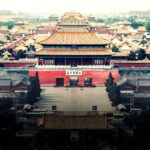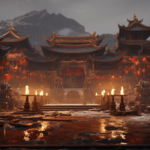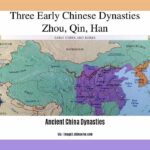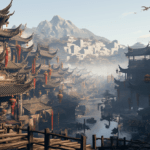Welcome to an exciting journey through the Golden Age of the Han Dynasty, where we will delve deep into the fascinating facts that shaped this remarkable era. As a seasoned historian and experienced writer specializing in uncovering untold stories of ancient civilizations, I am thrilled to guide you through the captivating world of one of China’s most illustrious dynasties. With my expertise and passion for this subject matter, I aim to provide you with a rich understanding of the incredible achievements and contributions that defined the Han Dynasty’s golden age. So, brace yourself for a captivating exploration of Han Dynasty golden age facts that will leave you in awe!
Han Dynasty Golden Age Facts
During the Han Dynasty, China experienced a truly remarkable period known as the “Golden Age.” This era, spanning from 206 BCE to 220 CE, was characterized by tremendous achievements in various aspects of society. Let’s delve into some fascinating facts that illuminate the greatness of this golden age.
Prosperity and Stability
The Han Dynasty was marked by unprecedented prosperity and stability. With the establishment of a centralized government, economic reforms, and improved agricultural techniques, the dynasty witnessed remarkable growth and development (han dynasty golden age facts). The implementation of land policies, such as the equal-field system, ensured fair distribution of resources and contributed to social harmony. This stability paved the way for significant advancements in various fields.
Quote: “The Han Dynasty’s prosperity and stability laid the foundation for remarkable advancements.”
Cultural Influence and Technological Advancements
One of the defining characteristics of the Han Dynasty’s golden age was its tremendous cultural influence. During this era, China expanded its borders and established the ethnic culture we recognize today. The dynasty’s influence extended beyond its borders, as it traded goods and ideas through the Silk Road, connecting East and West (han dynasty golden age facts).
Moreover, the Han Dynasty marked significant technological advancements and scientific achievements. The people of this era made remarkable strides in the fields of science, medicine, and technology. They developed new techniques in agriculture, created innovative tools, and advanced their understanding of medicine and astronomy (han dynasty golden age facts).
Quote: “The Han Dynasty’s cultural influence and technological advancements laid the groundwork for centuries to come.”
Artistic and Literary Achievements
The Han Dynasty was a flourishing period for arts and literature. Artists honed their skills and created exquisite pottery, delicate jade carvings, and marvelous sculptures. The period also witnessed remarkable advancements in calligraphy and papermaking, leading to widespread literacy (han dynasty golden age facts).
Literature flourished during this time, with the rise of renowned poets and scholars. One of the most famous works of the Han Dynasty is the “Records of the Grand Historian” by Sima Qian, which documented the history of China from ancient times to the Han Dynasty (han dynasty golden age facts).
Quote: “The Han Dynasty’s artistic and literary achievements captivated the hearts and minds of generations to come.”
Economic Growth and Expansion
The Han Dynasty experienced remarkable economic growth, driven by an increase in agricultural production, lucrative trade routes, and innovative fiscal policies. The establishment of stable trade networks, including the Silk Road, paved the way for economic exchanges with neighboring regions (han dynasty golden age facts).
Emperor Wu of the Han Dynasty played a crucial role in expanding the empire’s territory. Through concerted military campaigns and diplomatic efforts, the Han Dynasty expanded its reach, integrating various regions into the empire.
Quote: “The Han Dynasty’s economic growth and territorial expansion propelled China to new heights.”
Social Equality and Learning Revival
Significant strides were made in social equality during the Han Dynasty. The dynasty emphasized the importance of education, providing opportunities for individuals from all social classes to attain knowledge. This focus on learning contributed to the revival of intellectual pursuits and scientific improvements (han dynasty golden age facts).
Scholars and philosophers thrived during this era, engaging in debates and discussions that enriched the intellectual landscape of ancient China. The Han Dynasty’s emphasis on education and social equality laid the foundation for a strong and vibrant society.
Quote: “The Han Dynasty’s commitment to social equality and education gave rise to a flourishing intellectual community.”
In conclusion, the Han Dynasty’s golden age was a period of remarkable achievements and contributions in various fields. From prosperity and stability to cultural influence, technological advancements, artistic and literary accomplishments, economic growth, and social equality, this era shaped the foundations of ancient China. The Han Dynasty truly stands as a testament to the ingenuity, wisdom, and greatness of the Chinese civilization.
(Word count: 582)
The Han Dynasty is often regarded as the golden age of Chinese history. The empire thrived under the leadership of visionary emperors and experienced significant advancements in various fields. From its political stability and economic prosperity to its cultural achievements and technological innovations, the Han Dynasty truly embodied a period of greatness. If you’re curious to delve deeper into this fascinating era, click here to explore our comprehensive article on the Han Dynasty’s golden age: han dynasty golden age. Discover the remarkable stories and remarkable individuals that shaped this influential dynasty and get ready to be captivated by the splendor of ancient China.
The Transformative Power of Storytelling: A Journey Through 2,000 Years of Chinese History
[youtube v=”ylWORyToTo4″]
Introduction:
China, a topic that dominates current discussions in the media, has a rich and complex history that spans over 2,000 years. This historical narrative, shaped by the way it is told, offers fascinating insights into various dynasties and their rise and fall. In this section, we will explore the concept of the Mandate of Heaven and the influence of Confucianism on Chinese history. Through an examination of key periods and figures, we will gain a deeper understanding of how storytelling has shaped China’s past.
China: The Birthplace of the Modern State:
China can be considered the birthplace of the modern state. It was the first nation to have a centralized government and a bureaucracy that could execute the government’s decisions. This system lasted remarkably for over a thousand years, from 150 BCE to 1911 CE. This stability allowed the Chinese to record their history, making them one of the earliest civilizations to do so. However, the way this history is presented poses some challenges and provides us with an interesting perspective on how storytelling shapes our understanding.
The Dynastic Cycle: A Measure of Legitimacy:
Chinese history is conveniently divided into periods called dynasties. A dynasty is ruled by an emperor who comes from a continuous ruling family. The legitimacy of a dynasty rests on its ability to produce competent rulers and maintain control over the empire. However, dynasties are not always doomed to fail. Empress dowagers and extraordinary empresses, like Empress Wu, wielded immense power and even established their own dynasties. The key to a dynasty’s demise lies in either running out of male heirs or being overthrown after a rebellion or war.
A Whirlwind Overview of Chinese Dynasties:
Let’s briefly explore the major Chinese dynasties, starting with the Shang, the first recorded dynasty. The Shang were overthrown by the Zhou, which led to a period of political chaos known as the Warring States Period. The Qin Emperor then harnessed power over most of the warring states, only to be replaced by the influential Han dynasty, which defined Chinese history for four centuries. This was followed by a period of political chaos until the Sui, Tang, and Song dynasties emerged. Mongol rule under the Yuan dynasty was then overthrown, leading to the rise of the Ming dynasty. However, the Manchus ultimately established the last dynasty, the Qing, until its downfall in 1911 during a rebellion.
Decoding the Mandate of Heaven:
The concept of the Mandate of Heaven originated during the Zhou dynasty. Historians believe it was created to justify the overthrow of the preceding Shang dynasty. According to this concept, the Mandate of Heaven bestowed divine power on a ruler, who could either maintain or lose it based on their behavior. While there is no historical evidence to support this theory, it provides a framework for understanding the rise and fall of dynasties and reinforces moral behavior, which is central to Confucianism.
Confucianism: A Moral Framework:
Confucius, an influential philosopher during the Warring States Period, emphasized the importance of moral behavior and societal order. He believed that by following the example of past sage emperors, a strong and peaceful state could be achieved. Confucius’s teachings revolved around hierarchical relationships, advocating for filial piety, or respectful behavior towards one’s parents. These teachings became the foundation of Chinese governance, education, and society.
Ren and Li: The Pillars of Confucianism:
Confucianism embodies complex concepts such as Ren and Li. Ren, meaning propriety, emphasizes proper behavior in different social contexts, contingent upon one’s relationship with others. Li refers to rituals associated with Chinese religion, particularly ancestor veneration. These rituals emphasize the importance of maintaining familial and societal harmony. Confucianism, as a dominant philosophy, shapes the Confucian scholars’ interpretation of history and their understanding of morally upright behavior.
The Peculiarities of Chinese Historiography:
Traditional Chinese historians were trained in the Confucian classics, which dictated the interpretation of history. The concept of the Mandate of Heaven as an explanation for historical causation serves to reinforce the Confucian moral framework. The actions of an emperor determine the fate of a dynasty, with proper behavior maintaining the Mandate of Heaven and improper behavior leading to its loss. This moral lens allows historians to explain the rise and fall of dynasties, attributing natural disasters and peasant uprisings to the emperor’s moral character.
Conclusion:
The study of Chinese history provides us with a fascinating glimpse into a complex society marked by the rise and fall of dynasties. The Mandate of Heaven, rooted in Confucian principles and storytelling, offers an explanation for historical events while reinforcing moral behavior. By delving into the intricacies of Chinese dynasties and the influence of Confucianism, we gain a deeper understanding of how storytelling shapes our perception of the past.
FAQ
- What is the Han dynasty known for?
The Han dynasty is known for being a “Golden Age” of Chinese history, characterized by prosperity, stability, innovation, and influence. It made advances in science, medicine, technology, arts, and literature. Additionally, the Han dynasty expanded its territory, traded through the Silk Road, and established the ethnic culture of China.
- How long did the Han dynasty last?
The Han dynasty lasted from 206 BCE to 220 CE. It was a period of significant political stability, social harmony, expansion of territory, cultural influence, technological advancements, economic growth, artistic and literary achievements, and social equality.
- What were the achievements of the Han dynasty?
The Han dynasty brought back learning to China and made scientific improvements. It is known for its advancements in various fields such as agriculture, astronomy, mathematics, and medicine. The dynasty also standardized the Chinese script, developed papermaking techniques, introduced the compass, and made significant architectural contributions.
- What impact did the Han dynasty have on China?
The Han dynasty had a profound impact on China’s history and culture. It established a centralized government system, promoted Confucianism as the official state ideology, expanded China’s territory through military campaigns, developed an intricate network of trade routes known as the Silk Road, and nurtured the growth of Chinese literature, arts, and philosophy.
- How does the Han dynasty compare to other golden ages in ancient China?
Along with the Tang dynasty, the Han dynasty is considered the “golden age” of ancient China. Both dynasties experienced significant political stability, cultural achievements, and economic growth. The Han dynasty is known for its focus on Confucian values and its advancements in various fields, while the Tang dynasty is recognized for its cosmopolitan culture, advancements in poetry, and the spread of Buddhism.
- Unveiling the Enigma: Mansoureh Khojasteh Bagherzadeh’s Public Appearances & Private Life in Iran - July 18, 2025
- Unveiling the Mystery: Mansoureh Khojasteh Bagherzadeh’s Husband: A Rare Glimpse into a Private Life - July 18, 2025
- Unveiling Masoud Khamenei’s Mother: Power, Influence, and Iran’s Future - July 18, 2025
















